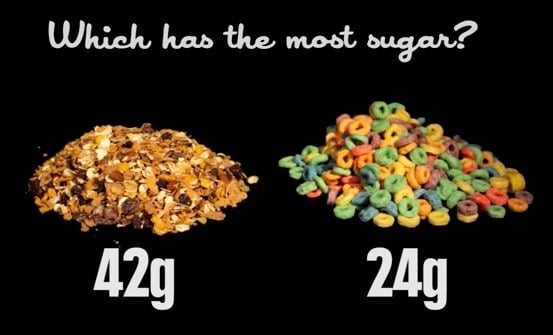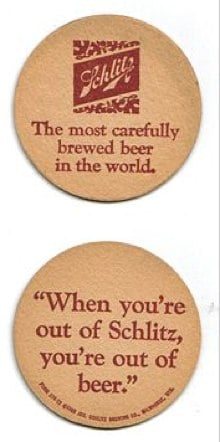Latest Gear Live Videos
How much sugar is in random foods? [Video]

Posted by Andru Edwards Categories: Fast Food, Health, Trends, Videos, Food Trivia,

Did you know that a Hot n Spicy McChicken sandwich has 17 grams more sugar than a regular McChicken? Ot that light ranch dressing has twice the amount of sugar as regular old ranch? Yeah, sugar hides out in the most unexpected places. Check out the video below for a few more surprises.
Click to continue reading How much sugar is in random foods? [Video]
Advertisement
Schlitz to Resume Brewing

Posted by Jenny Lewis Categories: Trends, Food Trivia, History, America, Midwest, Beer,
 After a number of unsuccessful changes to the brand, the Schlitz brewery (one of the oldest of the old school breweries) closed in 1981. First brewed in 1849, Schlitz beer was successful for over 100 years before changes in production (and the overall quality of the final product) killed the product’s popularity and, therefore, sales. The brand changed hands twice - once in 1982 to Stroh and earlier this year to Pabst - and is now being brewed again and is in such high demand that stores are reportedly limiting the numbers of cases customers can buy at one time.
After a number of unsuccessful changes to the brand, the Schlitz brewery (one of the oldest of the old school breweries) closed in 1981. First brewed in 1849, Schlitz beer was successful for over 100 years before changes in production (and the overall quality of the final product) killed the product’s popularity and, therefore, sales. The brand changed hands twice - once in 1982 to Stroh and earlier this year to Pabst - and is now being brewed again and is in such high demand that stores are reportedly limiting the numbers of cases customers can buy at one time.
Though brewing operations are on the east coast, Schlitz is currently only available in Milwaukee, Chicago, Minneapolis and Western Florida. Pabst is hopeful that the new old brew will be more widely available as brewing operations ramp up.
MSNBC
 I admit. I am addicted to limes, and lemons if I don’t have any limes left. I haven’t confessed this to many family members but now the word is out. My husband will tell you that we don’t tip the waiter if he forgets the lemon for my water (totally just kidding!). I juice raw vegetables almost every day and I always juice with lemons or limes, it really helps cut the “green” taste and just gives the juice such great flavor. The Worlds Healthiest Foods has a great article about the health benefits of lemons and limes and some good history as well. But I will leave you with some other great tips on why lemons and limes are so great and why I personally love them so much…
I admit. I am addicted to limes, and lemons if I don’t have any limes left. I haven’t confessed this to many family members but now the word is out. My husband will tell you that we don’t tip the waiter if he forgets the lemon for my water (totally just kidding!). I juice raw vegetables almost every day and I always juice with lemons or limes, it really helps cut the “green” taste and just gives the juice such great flavor. The Worlds Healthiest Foods has a great article about the health benefits of lemons and limes and some good history as well. But I will leave you with some other great tips on why lemons and limes are so great and why I personally love them so much…
- Lemons/limes have several times more Vitamin C than oranges.
- Lemons/limes are known to cure headaches in some people. I personally drink the juice of at least one lemon a day with water and it really helps.
- Lemons/limes have properties that can prevent cancer.
- Lemons/limes are alkaline so they can be great for someone who is struggling with their pH level.
- Lemons/limes have been known to help with asthma.
- Lemon/lime juice mixed with water promotes the exiting of one’s food in a timely manner.
- You can squeeze fresh or bottled lemon/lime juice on your cutting board after you’ve used it for cutting an onion or garlic, to cut the smell.
Note - if you do decide to become a lemon fanatic like me, invest in some straws as lemon juice can also eat away at the enamel on your teeth, if you drink it with a straw you should be fine!
So how about you? What wonderful uses have you found for these tart treats?
 Besides hot coffee, you can be served up plain iced coffee (usually with milk added), iced cappuccino, and even iced espresso. You can also have your coffee in forms other than liquid. There is coffee flavored ice cream, chocolate covered coffee beans, and even coffee syrups to put over ice cream or puddings. You can put coffee in cakes, frostings, cookies, and candies. You can even have Mocha Sodas and Frosted Mochas.
Besides hot coffee, you can be served up plain iced coffee (usually with milk added), iced cappuccino, and even iced espresso. You can also have your coffee in forms other than liquid. There is coffee flavored ice cream, chocolate covered coffee beans, and even coffee syrups to put over ice cream or puddings. You can put coffee in cakes, frostings, cookies, and candies. You can even have Mocha Sodas and Frosted Mochas.
For Mocha Sodas:
Mix a half cup of strong coffee with 2 cups milk. Put a scoop of chocolate ice cream in each of four soda glasses. Pour the coffee-milk mix into each glass, dividing it equally among the four glasses. Finish off each glass with club soda or other fizzy drink, and top with whipped cream.
Frosted Mochas are a blend of coffee, chocolate syrup, and vanilla ice cream.
 Coffee has replaced the malt or soda as the drink of choice among teens who want to hang out with their friends in a place with ambiance. Coffeehouses are springing up all over the country, providing rich brews mixed with lots of milk and whipped cream. Though there has been some concern about caffeine content, most teens aim for lattes, mochas, and cappuccinos, drinks with lots of steamed milk. Some are even savvy enough to order decaf. Recent research is showing that coffee, in moderation, may even help with concentration. And for some parents trying to get more milk into their teenagers, coffeehouse brews aren’t that bad.
Coffee has replaced the malt or soda as the drink of choice among teens who want to hang out with their friends in a place with ambiance. Coffeehouses are springing up all over the country, providing rich brews mixed with lots of milk and whipped cream. Though there has been some concern about caffeine content, most teens aim for lattes, mochas, and cappuccinos, drinks with lots of steamed milk. Some are even savvy enough to order decaf. Recent research is showing that coffee, in moderation, may even help with concentration. And for some parents trying to get more milk into their teenagers, coffeehouse brews aren’t that bad.
Not only are teens drinking more coffee, but they are also dispensing these savory drinks at local coffeehouses. In fact, some of these young baristas are so into coffee that they go on to compete in national latte art competitions. That is, they create images in the foamy milk: hearts, leaves, trees, etc.
 Once forbidden to women, thinking it would make them sterile, coffee has become the world’s favorite drink. It is brewed in various strengths and served with additions according to local custom. In Italy, most people drink espresso with sugar. The English and a lot of Americans use milk (or a non-dairy creamer) with or without sugar (or a sugar substitute). In Germany and Switzerland, people enjoy coffee with equal parts of hot chocolate; and the Belgians just add chocolate. In Mexico, it is drunk with cinnamon. The Ethiopians serve coffee with a pinch of salt tossed in, and the people of the Middle East drink their brew with cardamon and spices. Australians like coffee with whipped cream, and the Egyptian people take coffee strong and black, adding sugar only at weddings.
Once forbidden to women, thinking it would make them sterile, coffee has become the world’s favorite drink. It is brewed in various strengths and served with additions according to local custom. In Italy, most people drink espresso with sugar. The English and a lot of Americans use milk (or a non-dairy creamer) with or without sugar (or a sugar substitute). In Germany and Switzerland, people enjoy coffee with equal parts of hot chocolate; and the Belgians just add chocolate. In Mexico, it is drunk with cinnamon. The Ethiopians serve coffee with a pinch of salt tossed in, and the people of the Middle East drink their brew with cardamon and spices. Australians like coffee with whipped cream, and the Egyptian people take coffee strong and black, adding sugar only at weddings.
Coffee Types: Asia and Pacific Coffees
Posted by Janie Franz Categories: Food Trivia, History, Coffee,
 These coffees come from India, Indonesia, New Guinea, and Hawaii. Those from Indonesia (Sumatra, Sulawesi, and Java) and New Guinea are perhaps some of the most famous. They are rich, full bodied, and have complex acidity. Mandheling from Sumatra is the most full-bodied in the world but has low acidity. Sulawesi Toraja is rich with a bit more acidity and Djampit from Java, though bearing more acidity, is a lighter brew.
These coffees come from India, Indonesia, New Guinea, and Hawaii. Those from Indonesia (Sumatra, Sulawesi, and Java) and New Guinea are perhaps some of the most famous. They are rich, full bodied, and have complex acidity. Mandheling from Sumatra is the most full-bodied in the world but has low acidity. Sulawesi Toraja is rich with a bit more acidity and Djampit from Java, though bearing more acidity, is a lighter brew.
Finally, Kona coffee from Hawaii is worth its price tag. It is becoming harder to find in quantity. It is rich, medium-bodied, and extremely aromatic with floral undertones.
Coffee Types: African and Arabian Coffees
Posted by Janie Franz Categories: Food Trivia, History, Coffee,
 From the cradle of coffee origins, these coffees are luxurious and some of the most distinctly flavored in the world. Yemen Mocha is the most ancient coffee in the world. It does not have a syrupy, chocolate flavor, as its name might imply—though there is a hint of chocolate in its lingering, dry finish. Mocha coffee was named for the port of Mocha from which the coffee was shipped in ancient times. The coffee is medium to full bodied, with some acidity, and rich undertones. It is one of the few originally organically grown coffees in the world.
From the cradle of coffee origins, these coffees are luxurious and some of the most distinctly flavored in the world. Yemen Mocha is the most ancient coffee in the world. It does not have a syrupy, chocolate flavor, as its name might imply—though there is a hint of chocolate in its lingering, dry finish. Mocha coffee was named for the port of Mocha from which the coffee was shipped in ancient times. The coffee is medium to full bodied, with some acidity, and rich undertones. It is one of the few originally organically grown coffees in the world.
Ethiopian Harrar is an irregular brew, depending on how the coffee is prepared. It can range from strong, almost gamey flavor and roughness to a fragrant, rich, fruit-like cup. The difference is usually in whether these beans are washed or not. Other washed brews are Sidamo or Washed Sidamo (these are gentle, flowery) or Yirgacheffe or Yrgacheffe (rich, complex, flowery with a long finish).
Other African coffees are Kenyan, Tanzanian, Ugandan, and Zimbabwe coffees. Kenyan coffees are dry, full-bodied, and rich. Tanzanian coffees are sharp, acidic, and medium to full bodied. Newer coffees like Ugandan Bugishu and Zimbabwe coffee are lighter and less rich than Kenyan.
Coffee Types: Central American Coffees
Posted by Janie Franz Categories: Food Trivia, History, Coffee,
Mexican coffees are very mild brews, good for folks who take their coffee black and want a light, acidic coffee. Guatemalan coffees are world famous, especially the Antigua coffees. These are very acidic with a spicy or smoky tone. They are full bodied and rich.
Coffee from El Salvador is very mild and slightly sweet, in stark contrast to the rich, robust beans from Costa Rica. These robust brews can be found in specialty stores under these names: Tarrazu, Tres Rios, Heredia, and Alajuela.
Caribbean Coffees: Jamaican Blue Mountain coffee has had a lot of hype lately. It is indeed one of the premier coffee plantations of the world. A number of highland growers are labeling their coffees Blue Mountain, whether they are grown on the designated Blue Mountain estates or not. The real Blue Mountain is designated Wallensford or Silver Hill Estate Mountain. It is smooth, well-bodied, rich and very expensive.
Santo Domingo coffee from the Dominican Republic can be found in stores as Bani, Ocoa, and Barahona. Bani is a mellow brew. Barahona is heavier and more acid coffee, similar to true Jamaican Blue Mountain. Haitian coffee is mild, light in body and acidity, with a soft, rich flavor.
Coffee Types: Latin American Coffees
Posted by Janie Franz Categories: Food Trivia, History, Coffee,
 There is good coffee coming from every part of the world, though some types have a bit more prestige than others. Latin American coffees are considered the best by many connoisseurs.
There is good coffee coming from every part of the world, though some types have a bit more prestige than others. Latin American coffees are considered the best by many connoisseurs.
Columbian coffee is the coffee most Americans know about. But there are many different kinds of Columbian coffee which vary depending on where they are grown in that country. In general, however, Columbian coffees are full-bodied, with medium acidity, and modestly rich. Today, many of the ancient arabica coffee strains are being replaced with faster-growing, heavier-bearing plants. These new beans are inferior to those from older plants, but may soon flood the Columbian market.
Brazilian Bourbon Santos is smooth, medium bodied, and has moderate acidity. Though good, it is still a plain cup and has only been a gourmet curiosity.
Venezuelan coffee is remarkably low in acid. The finest, Meridas, has good body with light richness. It is good served straight without milk or flavors and is good in blends.
Chanchamayo from Peru produces a mild, light brew with a lot of flavor and aroma. It is often blended with darker roasts or as a base for flavored coffees.
Advertisement
© Gear Live Media, LLC. 2007 – User-posted content, unless source is quoted, is licensed under a Creative Commons Public Domain License. Gear Live graphics, logos, designs, page headers, button icons, videos, articles, blogs, forums, scripts and other service names are the trademarks of Gear Live Inc.



